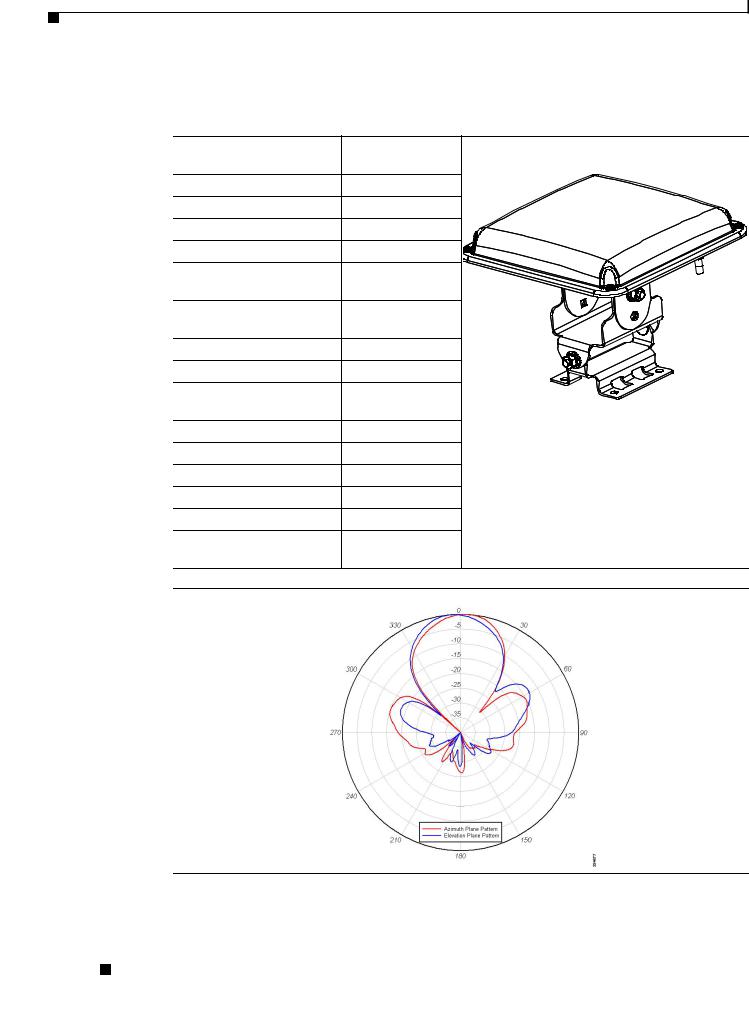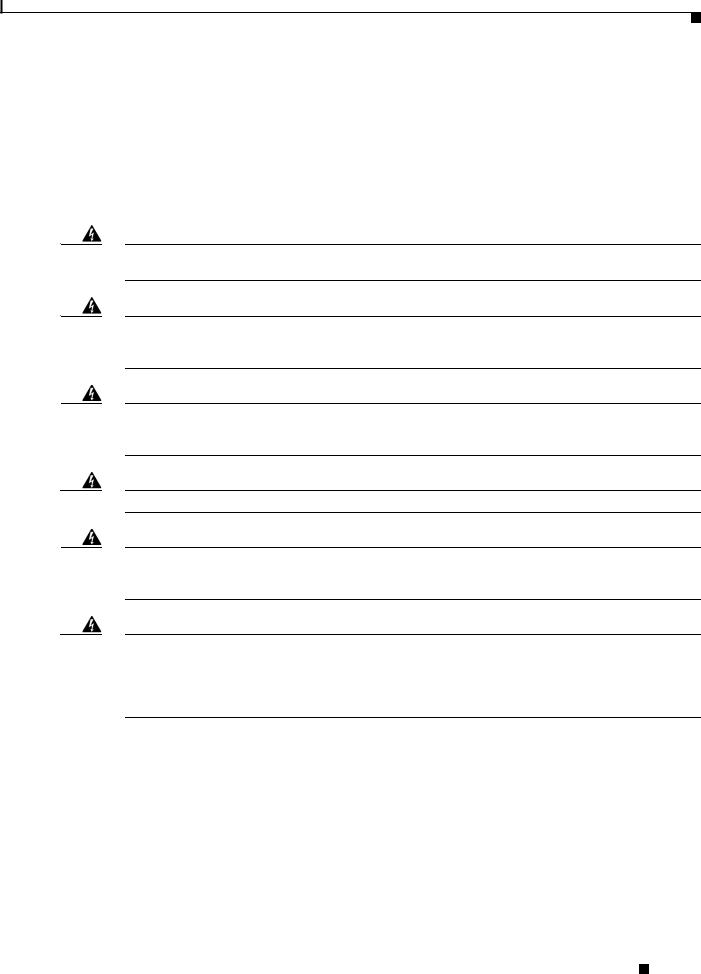Cisco Systems AIRANT5114P2MN User Manual

Cisco Aironet 5-GHz 14-dBi Directional Antenna
(AIR-ANT5114P2M-N)
This document outlines the specifications for the Cisco Aironet AIR-ANT5114P2M-N 5-GHz 14-dBi 2-Port Directional antenna with N-type connectors and provides instructions for mounting it. The antenna operates in the 5-GHz frequency band and is designed for use in outdoor environments.
The following information is provided in this document.
•Technical Specifications, page 2
•System Requirements, page 3
•Safety Precautions, page 3
•Installation Guidelines, page 4
•Installing the Antenna, page 5
•Obtaining Documentation and Submitting a Service Request, page 13
Cisco Systems, Inc.
www.cisco.com

Technical Specifications
Technical Specifications
Antenna type |
2-Element Patch |
|
|
Array |
|
Operating frequency range |
5150–5900 MHz |
|
Nominal input impedance |
50 Ohms |
|
Peak gain |
14 dBi |
|
Polarization |
Linear, Dual |
|
Elevation plane 3-dB |
30° |
|
beamwidth |
|
|
Azimuth plane 3-dB |
30° |
|
beamwidth |
|
|
Sidelobe level |
< –15 dBc |
|
Front-to-back ratio |
> 25 dB |
|
Cable length and type |
30 in. (76.2 cm) |
334576 |
|
outdoor rated Coax |
|
Connector type |
N Male |
|
Length |
7.8 in. (19.8 cm) |
|
Width |
7.8 in. (19.8 cm) |
|
Height |
1.2 in. (3 cm) |
|
Weight |
21.6 oz. (0.61 kg) |
|
Operating temperature range |
–40°F to 131°F |
|
|
(–40°C to 55°C) |
|
Elevation and Azimuth Plane Patterns
Cisco Aironet 5-GHz 14-dBi Directional Antenna (AIR-ANT5114P2M-N)
2 |
78-20958-01 |
|
|

System Requirements
System Requirements
This antenna is designed for use with Cisco Aironet access points and bridges but can be used with any 5-GHz Cisco Aironet radio device that uses an N-male connector.
Safety Precautions
Warning Installation of this antenna near power lines is dangerous. For your safety, follow the installation directions.
Warning This warning symbol means danger. You are in a situation that could cause bodily injury. Before you work on any equipment, be aware of the hazards involved with electrical circuitry and be familiar with standard practices for preventing accidents.
Warning In order to comply with international radio frequency (RF) exposure limits, dish antennas should be located at a minimum of 8.7 inches (22 cm) or more from the bodies of all persons. Other antennas should be located a minimum of 7.9 inches (20 cm) or more from the bodies of all persons.
Warning Do not work on the system or connect or disconnect cables during periods of lightning activity.
Warning This equipment must be grounded. Never defeat the ground conductor or operate the equipment in the absence of a suitably installed ground conductor. Contact the appropriate electrical inspection authority or an electrician if you are uncertain that suitable grounding is available.
Warning Do not locate the antenna near overhead power lines or other electric light or power circuits, or where it can come into contact with such circuits. When installing the antenna, take extreme care not to come into contact with such circuits, as they may cause serious injury or death. For proper installation and grounding of the antenna, please refer to national and local codes (e.g. U.S.:NFPA 70, National Electrical Code, Article 810, in Canada: Canadian Electrical Code, Section 54).
Each year hundreds of people are killed or injured when attempting to install an antenna. In many of these cases, the victim was aware of the danger of electrocution but did not take adequate steps to avoid the hazard.
For your safety, and to help you achieve a good installation, please read and follow these safety precautions. They may save your life!
1.If you are installing an antenna for the first time, for your own safety as well as others, seek professional assistance. Your Cisco sales representative can explain which mounting method to use for the size and type antenna you are about to install.
2.Select your installation site with safety, as well as performance in mind. Remember, electric power lines and phone lines look alike. For your safety, assume that any overhead line can kill you.
Cisco Aironet 5-GHz 14-dBi Directional Antenna (AIR-ANT5114P2M-N)
|
78-20958-01 |
3 |
|
|
|

Installation Guidelines
3.Call your electric power company. Tell them your plans and ask them to come look at your proposed installation. This is a small inconvenience considering your life is at stake.
4.Plan your installation carefully and completely before you begin. Successful raising of a mast or tower is largely a matter of coordination. Each person should be assigned to a specific task and should know what to do and when to do it. One person should be in charge of the operation to issue instructions and watch for signs of trouble.
5.When installing your antenna, remember:
a.Do not use a metal ladder.
b.Do not work on a wet or windy day.
c.Do dress properly—shoes with rubber soles and heels, rubber gloves, long sleeved shirt or jacket.
6.If the assembly starts to drop, get away from it and let it fall. Remember, the antenna, mast, cable, and metal guy wires are all excellent conductors of electrical current. Even the slightest touch of any of these parts to a power line complete an electrical path through the antenna and the installer: you!
7.If any part of the antenna system should come in contact with a power line, do not touch it or try to remove it yourself. Call your local power company. They will remove it safely.
8.If an accident should occur with the power lines call for qualified emergency help immediately.
Installation Guidelines
Because the antennas transmit and receive radio signals, they are susceptible to RF obstructions and common sources of interference that can reduce throughput and range of the device to which they are connected. Follow these guidelines to ensure the best possible performance:
•Mount the antenna as high as possible to take advantage of its propagation characteristics.
•Keep the antenna away from metal obstructions such as heating and air-conditioning ducts, large ceiling trusses, building superstructures, and major power cabling runs. If necessary, use a rigid conduit to lower the antenna away from these obstructions.
•The density of the materials used in a building’s construction determines the number of walls the signal must pass through and still maintain adequate coverage. Consider the following before choosing the location in which to install your antenna:
–Paper and vinyl walls have very little affect on signal penetration.
–Solid and pre-cast concrete walls limit signal penetration to one or two walls without degrading coverage.
–Concrete and wood block walls limit signal penetration to three or four walls.
–A signal can penetrate five or six walls constructed of drywall or wood.
–A thick metal wall causes signals to reflect, causing poor penetration.
•Install the antenna away from 5-GHz cordless phones. These products can cause signal interference because they operate in the same frequency range as the device your antenna is connected to.
Cisco Aironet 5-GHz 14-dBi Directional Antenna (AIR-ANT5114P2M-N)
4 |
78-20958-01 |
|
|

Installing the Antenna
Site Selection
Before attempting to install your antenna, determine where you can best place the antenna for safety and performance.
Follow these steps to determine a safe distance from wires, power lines, and trees.
Step 1 Measure the height of your antenna.
Step 2 Add this length to the length of your tower or mast and then double this total for the minimum recommended safe distance.
Caution If you are unable to maintain this safe distance, stop and get professional help.
Generally, the higher an antenna is above the ground, the better it performs. Good practice is to install your antenna about 5 to 10 ft (1.5 to 3 m) above the roof line and away from all power lines and obstructions. If possible, find a mounting place directly above your wireless device so that the lead-in cable can be as short as possible.
Installing the Antenna
You can install the antenna on a pole from 1.63” to 2.3” pipe O.D. The mounting options allow the antenna to be vertically or horizontally polarized.
Tools and Equipment Required
An installation kit is shipped with the antenna and consists of the panel antenna with adjustable mount and hardware, including:
•Antenna mount bracket
•Elevation adjustable bracket
•Azimuth adjustable bracket
•Four 1/4-in. 20x3/4 carriage bolts
•Six 1/4-in. 20 hex nuts
•Six 1/4-in. 20 spring lock washers
•Six 1/4-in. 20 flat washers
•Two pipe clamps
To attach the mount to the antenna and secure it to the pole, you need the following tools and equipment, which are not provided.
•7/16-in wrench
•5/16-in nut driver or flat head screwdriver for pipe clamps
The following sections contain typical procedures for installing the antenna on a pole. Your installation may vary. Before you begin, you may want to refer to Figure 1.
Cisco Aironet 5-GHz 14-dBi Directional Antenna (AIR-ANT5114P2M-N)
|
78-20958-01 |
5 |
|
|
|
